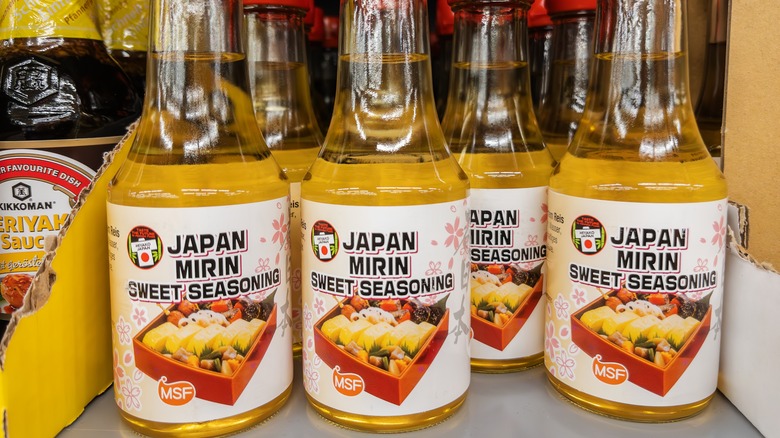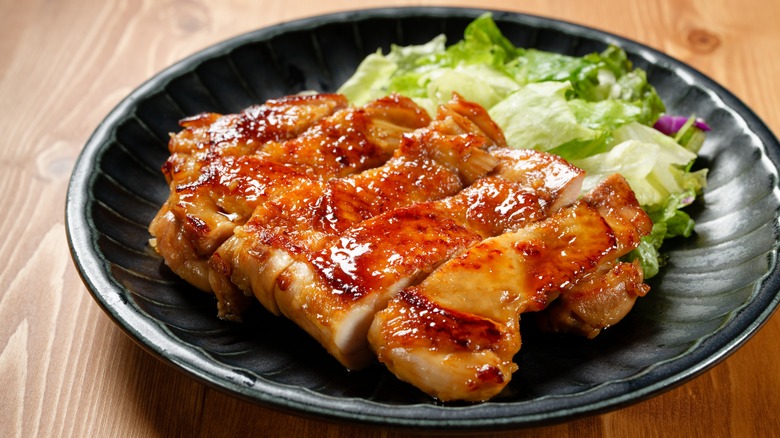Make Your Fried Rice Unforgettable With One Extra Ingredient
So, you're making your favorite fried rice recipe. Chances are you've got your veggies and eggs all lined up, and perhaps some bacon or shrimp if you're feeling fancier. Ideally, you're using pre-cooked rice that's a day or two old (this stops it from getting soggy), and when it comes to seasonings, you're probably using soy sauce and maybe some sesame oil. But to kick your homemade fried rice up a notch, there's one more liquid you should consider adding: Mirin.
Mirin is a Japanese cooking wine made from rice but with less dryness and alcohol content than sake. It's a great addition because the sweet taste complements the saltier, savory notes from soy sauce (or oyster sauce, another popular fried rice addition). This way, you'll get a more rounded dish with an extra dimension from the sweetness, without crossing over into it being sugary. And mirin works better than just adding a purely sweet ingredient, as it also has some tangy, umami-rich elements since it's a fermented product.
Adding mirin to fried rice
Although mirin is similar to sake, the two are not identical: Mirin is made with a mix of regular steamed rice, koji rice (rice that's been fermented with a special fungus), and shochu, a Japanese spirit that can be made with rice, barley, sweet potatoes, or other plants. (Sake doesn't contain any shochu but is made with yeast instead.) It's typically fermented for a month or two, though it can be aged over several years, turning darker. There are a few different types. "Hon mirin" is the purest, while "aji mirin" may be padded with additives like corn syrup. You should be able to find mirin in Asian grocery stores; supermarkets like Walmart may also carry it.
Mirin is considered by some to be the key to making fried rice taste restaurant-quality. You won't need to add much of it to reap the benefits: A tablespoon should be enough, although some recipes use a bit more or less. Remember, it's sweet, so don't overdo it and turn your dish into fried rice pudding. Mix it together with the other liquids (like soy sauce and sesame oil) and stir them in at the same time as the rice, mixing them up so everything gets evenly coated.
If you're looking to add even more flavor, don't stop at mirin – break out some fish sauce (but be sparing, too much will make the dish a salt bomb). You can add it during the same step.
Other uses for mirin
Although mirin works formidably in Chinese dishes like fried rice, it's more common in Japanese cuisine — after all, that's where it's from. It works in a pretty wide range of dishes. Paired with soy sauce, it's a key ingredient in teriyaki sauce (it adds that characteristic sweetness); it can figure into ramen and salad dressings, too. It's also used in glazes and marinades for meat or fish. Mirin also works well in dipping sauces for items like tempura or sashimi, where, just like with fried rice, it can round out salty elements like soy sauce with a subtle sweet kick.
Shaoxing, a Chinese cooking wine, will also work similarly to mirin, as it's made in a slightly different process that uses wheat. Shaoxing wine can be used to similar effect in marinades, glazes, or just to add an extra layer to a stir-fry.
If you can't get your hands on mirin or shaoxing, you can try substituting rice vinegar, although you'll need to add sugar to get the sweetness back in. A half-teaspoon of sugar for each tablespoon of rice vinegar should work.


